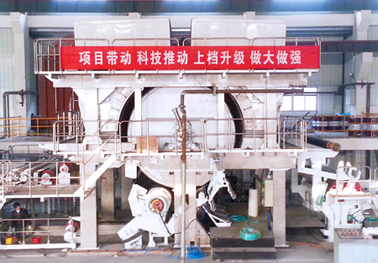When we choose and purchase gas hoods, we are hesitant to start with a wide variety of gas hoods, and then compare the differences between different gas hoods. Today, the editor will lead you to focus on understanding the differences between semi open and closed gas hoods?
1. Impact on drying capacity
Semi open hood: Due to the failure to provide a high-temperature environment and high exhaust air volume, high-speed hot air is not fully utilized, and the improvement effect on dry talent is not significant.
Closed hood: Combined with well planned bag area air supply, it can improve drying efficiency by 10-20% per ton of steam consumption, and reduce steam consumption per ton of paper by approximately 0.2 tons,
2. Correction of lateral moisture content in the paper web
Semi open hood: Due to the large exhaust air volume, the airflow velocity on both sides of the paper web is higher. In the total makeup air volume, the proportion of the bag area blowing box is small, making it difficult to correct the lateral moisture difference of the paper web.
Closed hood: The segmented bag area blowing box can control the airflow inside the hood to flow from the center of the paper web to both sides, thereby removing excess moisture from the center of the paper web and correcting lateral moisture on the paper web.

3. The possibility of condensation and dripping inside the hood
Semi open hood: By increasing the exhaust air volume and dedicating oneself to energy to ensure safe production, but due to the uncontrolled airflow inside the hood, there may still be blind spots with poor ventilation and condensation and dripping.
Closed hood: Effectively controls the flow and dew point temperature of the air inside the hood, allowing the paper machine to operate under ideal ventilation conditions that are most conducive to moisture removal, completely avoiding partial condensation and dripping inside the hood.
4. Impact on the operating environment
Semi open hood: The environment in the paper making workshop is harsh, with cool winters and hot summers. If the ventilation in the workshop is not good, it is highly likely that the workshop will condense and drip during the rainy season.
Closed hood: The tightness and zero position control of the hood ensure that the moisture inside the hood will not be emitted into the workshop, greatly reducing environmental pollution to the workshop. In conjunction with reasonably planned factory ventilation, the workshop can maintain charming temperature and humidity throughout the year.
5. Exhaust air volume
Semi open hood: According to the papermaking standard, the water vapor ratio of the half open hood is 1:40, and the exhaust air volume is 350000kg/h. Six 60000 kg/h exhaust fans are required, with a total installed capacity of 22X6=132kW.
Closed hood: The exhaust temperature shall not be lower than 82C, the exhaust dew point temperature shall not be lower than 58C, and the exhaust air volume shall be 80000 kg/h. Two exhaust fans with a capacity of 30000kg/h shall be used for the front dryer, and one exhaust fan with a capacity of 20000 kg/h shall be used for the rear dryer. The total installed capacity is 22X2+7.5=51.5kw.

6. Impact on heat recovery
Semi open hood: The exhaust temperature is 65C, and the recovery efficiency of the heat recovery system is significantly lower than that of the closed hood. The equipment recovery period is 1-2 years.
Closed hood: Due to the exhaust temperature of 82C, moisture content of 0.14kgHO/kg.da, and high mixing value, it is classified as high-grade waste heat recovery. 50% of the winter air supply heat in the bag area and the paper workshop comes from waste heat recovery, and 20% of the heat energy evaporated by the drying staff from the paper is recovered. The equipment recovery period is about half a year.
7. Impact on plant ventilation
Semi open hood: The exhaust air volume of 350000 kg/h hood comes from the workshop, and in winter, most of this air needs to be supplemented by outdoor fresh air heated by fans and heaters.
Closed hood: Due to the basic balance between the exhaust air volume of the emerald and the supply air volume of the bag area, as long as 20000 kg/h of air seeps into the hood from the workshop, the supplementary air volume of the workshop in winter is reduced by 50%. This heat can partially come from the secondary air air heat recovery device of the hood exhaust.
The above are the materials provided by Fengxin Technology for you, hoping to be helpful to you.
![]()
| Mobile: + 86-15965759999 | |
| Tel.: + 86-0635-2531988 | |
| Email: fengxin@cnfengxin.cn | |
| Address: Hi tech Industrial Park, Linqing City, Shandong Province (shilitun, Xinhua office) |
